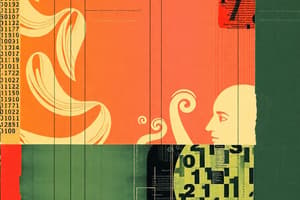Podcast
Questions and Answers
How would you access the second element of an array in the given code snippet?
How would you access the second element of an array in the given code snippet?
- arr[1]; (correct)
- arr{2};
- arr(2);
- arr.index(1);
What command would you use to modify the third element of the array?
What command would you use to modify the third element of the array?
- arr.update(3, 15);
- modify(arr, 3, 15);
- changeElement(arr, 15, 3);
- arr[2] = 15; (correct)
In JavaScript, how would you sort elements within an array?
In JavaScript, how would you sort elements within an array?
- arr.sortAscending();
- arr.sort(compareFunction); (correct)
- sortArray(arr);
- sortElements(arr);
Which function is used for binary search operation in the given context?
Which function is used for binary search operation in the given context?
What index would be used to access the first element of the array 'arr' in most programming languages?
What index would be used to access the first element of the array 'arr' in most programming languages?
How is the size of an array represented?
How is the size of an array represented?
Which method initializes an array with specific values enclosed within curly braces?
Which method initializes an array with specific values enclosed within curly braces?
How are 2D arrays represented when declared?
How are 2D arrays represented when declared?
In which method do you initialize an array with the number of elements followed by a semicolon and the keyword 'NULL'?
In which method do you initialize an array with the number of elements followed by a semicolon and the keyword 'NULL'?
How can elements be accessed from arrays?
How can elements be accessed from arrays?
Flashcards are hidden until you start studying
Study Notes
Array
Introduction
An array is a linear data structure that gathers elements of the same data type and stores them adjacent to each other. Arrays use an index system, starting at 0 and running through n-1, where n represents the size of the array. Various operations can be performed using arrays, such as searching, sorting, and editing elements efficiently.
Declaring Arrays
Arrays are typically declared using square brackets, specifying the size of the array as an argument. For instance, a 1D array is represented as follows:
int arr[n];
For 2D arrays, it is written as:
int arr[m][n];
And for 3D arrays:
int arr[m][n][o];
Initializing Arrays
There are several methods to initialize arrays:
Method 1
Initialize an array with specific values enclosed within curly braces:
int a = {2, 3, 5, 7, 11, 13};
Method 2
Use a generic initializer if some elements are not explicitly initialized:
int arr[]={1, 2, 5, 9, 4, 6, 3};
Method 3
Initialise an array with the number of elements, followed by a semicolon and the keyword "NULL":
int b[] = {1, 2, NULL};
Method 4
Certain programming languages allow you to assign zero to an entire array:
int c[] ={0};
Accessing Elements
Accessing elements from arrays can be done using the index of the desired element, counting from 0 for the first element. For example, to access the second element of an array called "arr", you would use the command:
printf("\n%d", arr);
This prints the second element of the array to the output.
Modifying Arrays
Modifying elements in an array is achieved by directly setting the desired value to the index corresponding to the particular element. For instance, to modify the third element of an array named "arr" with the value 15, you would use:
arr = 15;
This sets the third element of the array to the value 15.
Array Operations
Array operations include sorting, searching, and manipulating elements within arrays. These tasks can be performed using various built-in functions or methods provided by programming languages. For instance, in JavaScript, you can use the sort() method to sort elements within an array:
arr.sort(compare);
Or, you can perform a binary search operation using the binarySearch() function:
int pos = binarySearch(data, x);
These operations allow for efficient manipulation of arrays according to particular requirements.
Studying That Suits You
Use AI to generate personalized quizzes and flashcards to suit your learning preferences.




